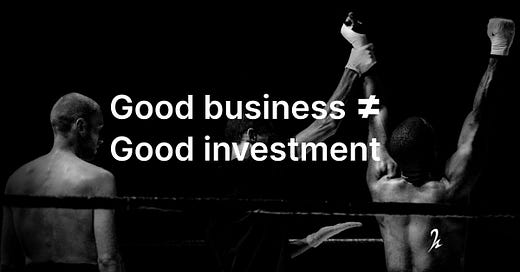Seeing significant traction at early-stage companies is rare. It gets even more special if the company is already cash flow positive. Exciting, right? This might be the opportunity everybody talked about.
Well, not so quick. There might be a catch that is often found at companies demonstrating quite a degree of maturity when they are raising their first angel round. The same is true for a lot of startups that are very interesting and logical from a business perspective, but fail to deliver returns from an investor’s perspective.
For angels, it’s especially difficult to distinguish these two perspectives, as most angels are entrepreneurs themselves.
Let’s see why a profitable early-stage business can actually turn out to be a bad investment after all, and what you should watch out for.
We continuously publish our thoughts on investment strategy and share our learnings with fellow angels.
Make sure to subscribe and don’t miss a piece.
How does the business generate value?
First things first: Take a look at where the actual business value coming from? Categorizing startups according to their value generation might actually be more helpful than looking into their revenue statistics.
For example, agencies and service driven business model might get to some significant traction quickly, but lack scalability and growth potential. Even if a startup labels themselves as a software business, dive into their revenue sources and product to understand how much is manual work vs. automatization.
Over the years we saw many companies actually trying to raise money on their (successful) service businesses, whilst labelling themselves as software companies. The transition from agency logics to software definitely can work, but also bears a lot of difficulties for early-stage companies that are not established yet.
For example, Johannis managed to transform ProductsUp from a service business to a true SaaS player - but all bootstrapped and without early-stage investment.
Your investment should make a difference
Early-stage investments should make a huge difference for the company. Actually pre-revenue it makes all the difference. If there are already some inflows of revenue, it should also challenge your investing perspective. Does your investment (or the total round) actually make a big difference? Should they rather raise a larger round, or might there be hidden reasons why they prefer to take on external funding for their growth?
If your investment doesn't really change much about the business, it might be a bad fit for an early-stage investment.
Don’t fund a stagnating business
Okay, so a business is making money, which is great. But what if it's not growing much?
We observed multiple founders over the years that reached some sort of early ceiling in their business. They then tended to go for external capital sources to increase their firepower. Instead, maybe they should have gone for more creative solutions and re-thinking their core business.
Even if there are high absolute revenue figure: If you see stagnation at an early-stage, deep dive into it and understand where this is coming from! While there can be multiple reasons for it (service business model, not keeping up with changing market trends, small market size, etc.) be very careful, if you don’t see a continues trajectory. Often external money is not the right answer for bootstrapped businesses, but an easy way out for founders.
Check the appetite for acquisitions
Never forget your actual goal: Exiting and selling your shares for a profit. Just like it’s true for VCs, it doesn’t make any sense for angels to go for an EBIT case. You need to sell at one point!
This also means: There need to be buyers. Obviously.
But it’s not that simple. Because there are so many types of buyers out there. In general, we look into the general market environment first. Are their incumbents or strategic buyers that are able and willing to acquire external IP and business in the midterm future? Is the market driven by acquisitions of larger or geographic competitors? Or is it even driven by PE acquisitions.
In addition, look into the acquisition multiples and their historical development. This is the easiest and most revealing check point for us to understand the growth targets of a startup at hand - e.g. do they need to grow to €20M ARR to reach a €100M exit value with a 5x multiple on revenue? Understanding the inner workings of acquisition multiples within industry verticals and growth stages is absolutely critical for early-stage investors!
Building a return profile is the key outcome here to take an educated guess how much return the startup might be able to generate in some years down the road.
Last, but not least: Does it match your portfolio economics?
Once you clarified the return profile, it’s essential to match it with your portfolio economics. While many angels don’t actually maintain a portfolio logic with their investment, we think this is extremely helpful to enable higher and less volatile returns in the long run.
Read more about return profiles of startups:
Here it comes to building your own strategy of individual risk and return preferences. If your strategy requires at least a potential of 50x returns for any startup in your portfolio, this serves as solid criteria for your investment decision. Depending on your portfolio economics, 5x potential might also be enough, but again every investment opportunity should at least match your lower bound before you go all in!
If you want to learn more about how we built our portfolio economics, feel free to pre-register for our Angel Crew Community. We share our insights and deal flow there with a selected group of fellow angels!
👋👋👋 Feel free to pre-register for our Angel Crew Community, where we share our weekly deal flow with our closer network!







